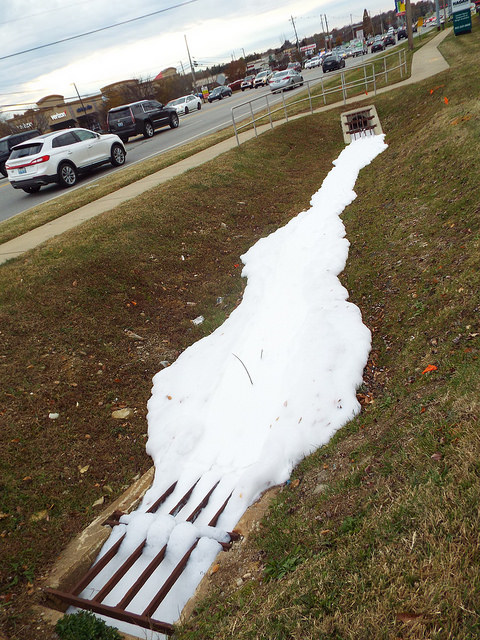Swale

|
| Photo credit: EX22218 - ON/OFF on Visualhunt.com / CC BY-NC-ND |
[edit] Introduction
Swales are natural or man-made linear depressions (or ditches), usually grass covered, with shallow-sloping sides. They are becoming more common as components in the drainage strategies of residential, commercial and municipal schemes.
Approved Document H - Drainage and Waste Disposal, describes ‘swales’ as:
‘…grass-lined channels which transport rainwater from a site as well as controlling flow and quality of surface runoff. Some of the flow infiltrates into the ground. There may be an overflow at the end into another form of infiltration device or a watercourse. They are particularly suitable for treatment of runoff from small residential developments, parking areas and roads.’
Their function is to:
- Slow the movement of water through the landscape after heavy rainfall;
- Reduce peak flows;
- Form a temporary reservoir;
- Direct water to a storage or discharge system and
- Facilitate the absorption of water into the ground.
Swales are frequently located alongside road verges, near the source of water run-off and can form a network linking storage ponds and wetlands. They can offer an efficient way of capturing rainwater and may form part of a sustainable urban drainage system (SuDS).
They can be both sustainable and economic because they are relatively easy to construct and can obviate the need for costly kerbs, gullies and gratings, as well as requiring little maintenance, other than mowing during the growing season. A grass length of around 150mm is considered optimal. Furthermore, swales can form good habitats for toads, newts and other amphibians which might have lower survival rates in conventional manufactured gullies.
[edit] How they work
In dry weather, a swale will hold little or no water. After a period of heavy rainfall, water will flow into the swale but its flow will be slowed by the grass which also filters out sediments and organic matter that remain on the top surface to be broken down naturally. Optimum performance usually relies on shallow slopes – both along the swale and on its sides. This may be further enhanced by installing check dams across the direction of flow; this will reduce the flow rate and lower the erosion risk.
A swale’s regulating function is enhanced by the processes of evaporation, infiltration into the surrounding soil and transpiration. If periods of exceptionally heavy rain are anticipated, overflows can be created to link to watercourses, storage ponds or wetlands.
Swales may recharge an underlying aquifer but if this is undesirable, an impermeable lining can be installed beneath the swale.
NB Trees in Hard Landscapes, A Guide for Delivery, published by the Trees and Design Action Group in September 2014, defines a swale as: ‘…a shallow vegetated channel designed to partially treat water quality, attenuate flooding potential and convey surface water runoff away from critical infrastructure.’
[edit] Related articles on Designing Buildings Wiki
- Are sustainable urban drainage systems the response to our changing climate?
- Bioretention system.
- Berm.
- Bund.
- Catchment flood management plans.
- Culvert.
- Detention pond.
- Drainage.
- Eutrophication.
- Rainwater harvesting.
- River engineering.
- Safe working in drains and sewers.
- Soakaway.
- SuDS infographic.
- SuDS - is there light at the end of the tunnel?
- Surface water
- Sustainable urban drainage systems SUDS.
- Water Act 2014.
- Water consumption.
- Water engineering.
Featured articles and news
The UK's Modern Industrial Strategy: A 10 year plan
Previous consultation criticism, current key elements and general support with some persisting reservations.
Building Safety Regulator reforms
New roles, new staff and a new fast track service pave the way for a single construction regulator.
Architectural Technologist CPDs and Communications
CIAT CPD… and how you can do it!
Cooling centres and cool spaces
Managing extreme heat in cities by directing the public to places for heat stress relief and water sources.
Winter gardens: A brief history and warm variations
Extending the season with glass in different forms and terms.
Restoring Great Yarmouth's Winter Gardens
Transforming one of the least sustainable constructions imaginable.
Construction Skills Mission Board launch sector drive
Newly formed government and industry collaboration set strategy for recruiting an additional 100,000 construction workers a year.
New Architects Code comes into effect in September 2025
ARB Architects Code of Conduct and Practice available with ongoing consultation regarding guidance.
Welsh Skills Body (Medr) launches ambitious plan
The new skills body brings together funding and regulation of tertiary education and research for the devolved nation.
Paul Gandy FCIOB announced as next CIOB President
Former Tilbury Douglas CEO takes helm.
UK Infrastructure: A 10 Year Strategy. In brief with reactions
With the National Infrastructure and Service Transformation Authority (NISTA).
Ebenezer Howard: inventor of the garden city. Book review.
The Grenfell Tower fire, eight years on
A time to pause and reflect as Dubai tower block fire reported just before anniversary.
Airtightness Topic Guide BSRIA TG 27/2025
Explaining the basics of airtightness, what it is, why it's important, when it's required and how it's carried out.
Construction contract awards hit lowest point of 2025
Plummeting for second consecutive month, intensifying concerns for housing and infrastructure goals.
Understanding Mental Health in the Built Environment 2025
Examining the state of mental health in construction, shedding light on levels of stress, anxiety and depression.
The benefits of engaging with insulation manufacturers
When considering ground floor constructions.
Lighting Industry endorses Blueprint for Electrification
The Lighting Industry Association fully supports the ECA Blueprint as a timely, urgent call to action.























